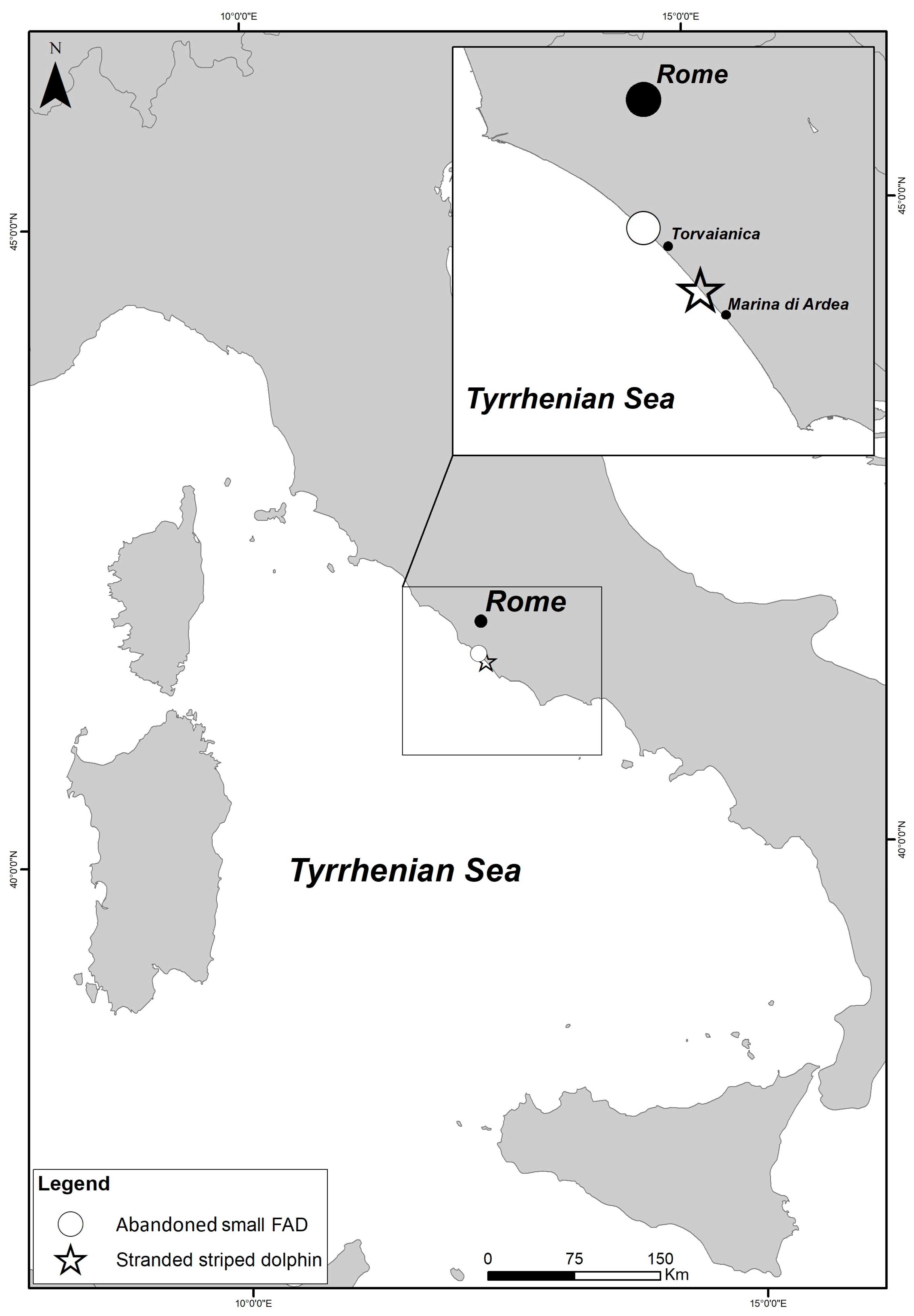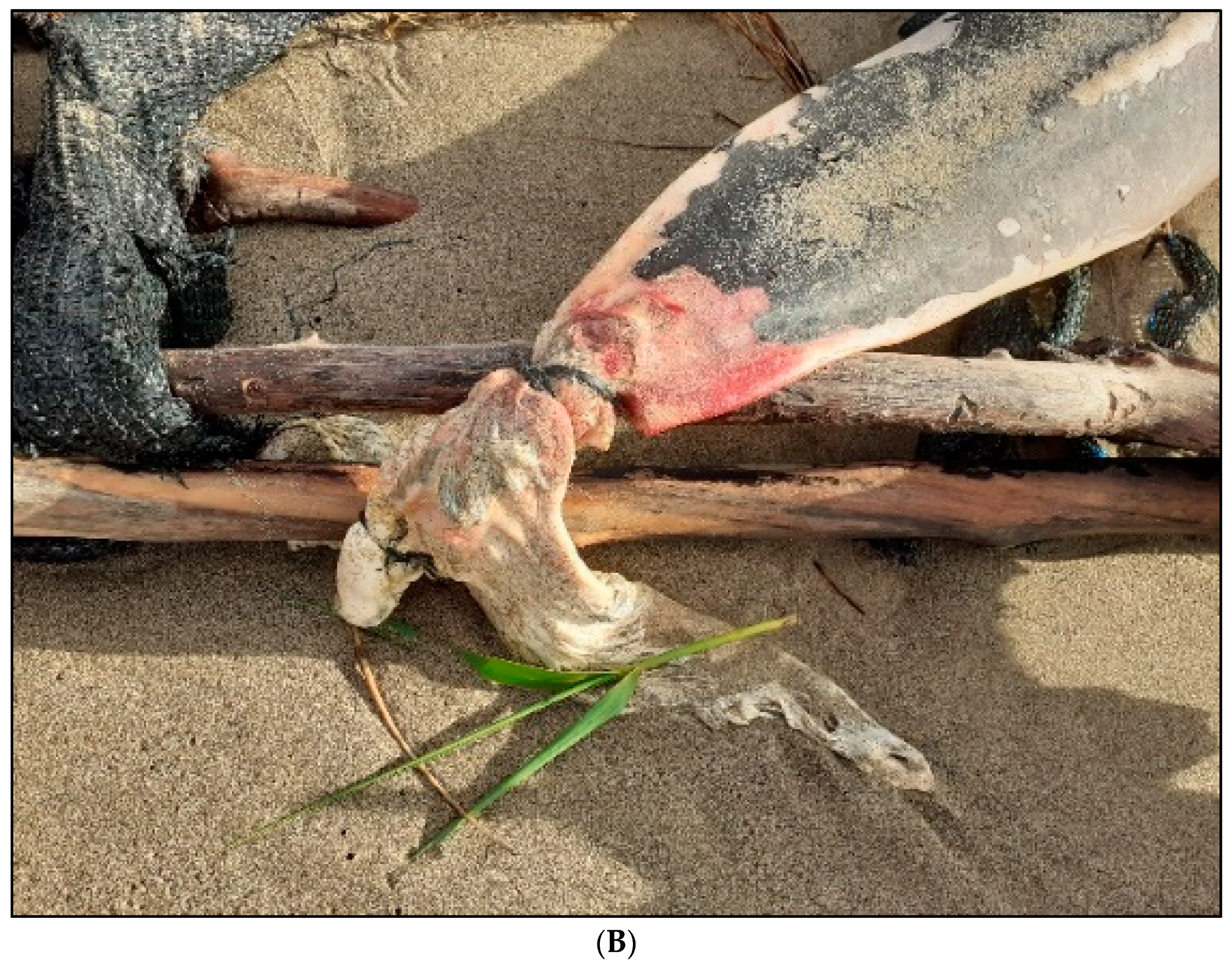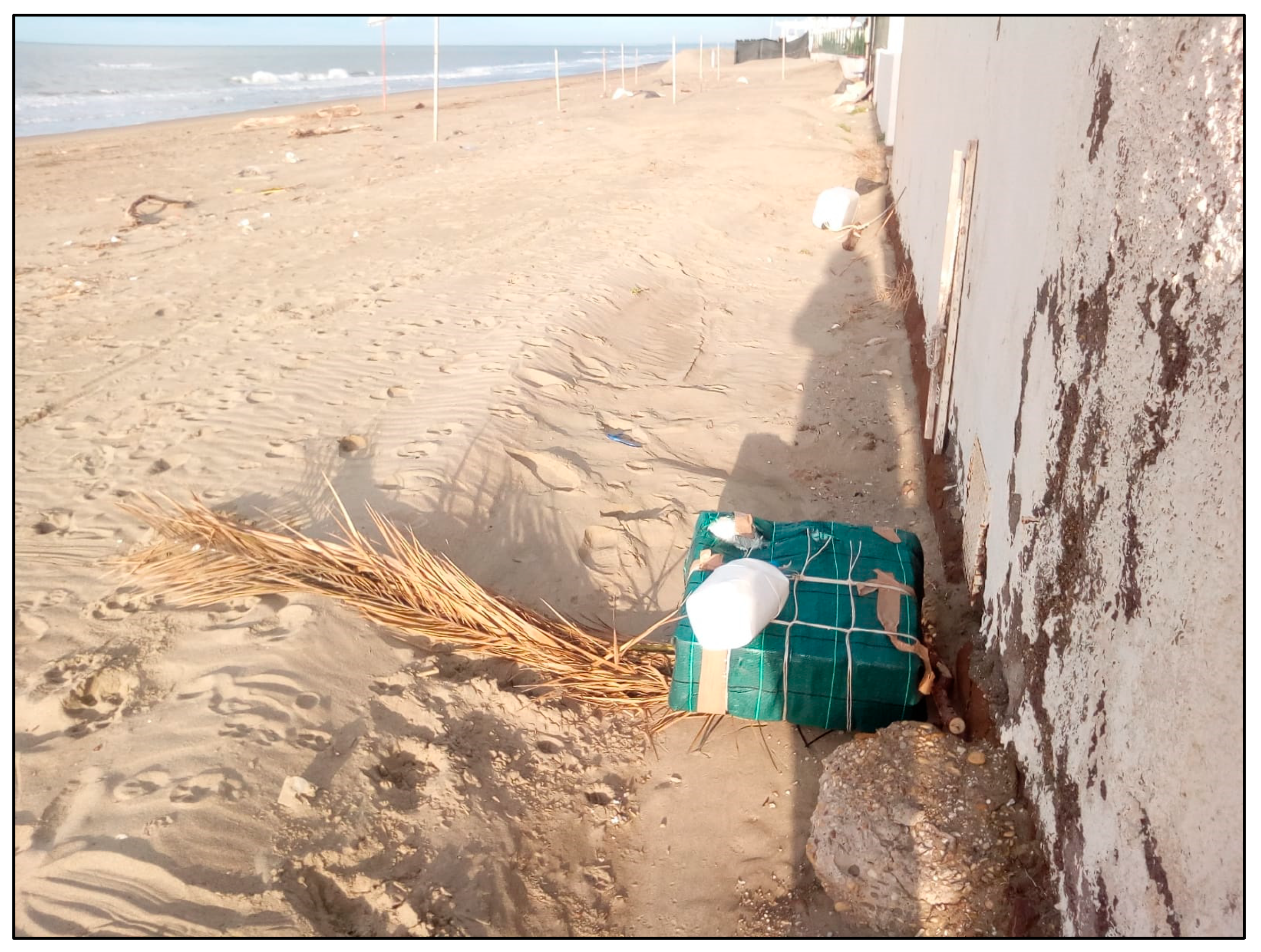First Record of Cetacean Killed in an Artisanal Fish Aggregating Device in the Mediterranean Sea
Abstract
Simple Summary
Abstract
1. Introduction
- (i)
- They target the common dolphinfish, and are only for vessels that hold a valid fishing authorization issued by the competent authorities;
- (ii)
- All their elements are made of biodegradable materials;
- (iii)
- Their surface elements are made of ‘material that involve minimal risk of entangling non-target species, especially vulnerable species, or affecting other vessels’;
- (iv)
- They are reliably locatable once deployed;
- (v)
- Their main rope is equipped with ‘an appropriate number of counterweights’ to make it sink to the sea bottom if the surface elements drift away;
- (vi)
- They are properly marked to be readily identified (i.e., visible registration numbers of fishing vessels);
- (vii)
- Vessels deploying FADs must record and report back to their national authorities all information on their fishing activities, including any loss of FADs with their latest position.
2. Materials and Methods
3. Results
4. Discussion
5. Conclusions
Author Contributions
Funding
Institutional Review Board Statement
Informed Consent Statement
Data Availability Statement
Acknowledgments
Conflicts of Interest
References
- Sinopoli, M.; Cillari, T.; Andaloro, F.; Berti, C.; Consoli, P.; Galgani, F.; Romeo, T. Are FADs a significant source of marine litter? Assessment of released debris and mitigation strategy in the Mediterranean Sea. J. Environ. Manag. 2020, 253, 109749. [Google Scholar] [CrossRef] [PubMed]
- Taquet, M. Fish aggregating devices (FADs): Good or bad fishing tools? A question of scale and knowledge. Aquat. Living Resour. 2013, 26, 25–35. [Google Scholar] [CrossRef]
- Morales-Nin, B.; Cannizzaro, L.; Massuti, E.; Potoschi, A.; Andaloro, F. An overview of the FADs fishery in the Mediterranean Sea. In Pêche Thonière et Dispositifs de Concentration de Poissons; Le Gall, J.Y., Cayré, P., Taquet, M., Eds.; Actes Colloq.; Ifremer: Brest, France, 2000; Volume 28, pp. 184–207. Available online: https://archimer.ifremer.fr/doc/00042/15286/ (accessed on 10 July 2023).
- Sechi, A.S.D.; Pietrasanta, R.; Morello, A.; Caruso, F.; Bocconcelli, A.; De Lorenzi, T.; Rosso, M. The ghost labyrinth: Quantifying illegal Fish Aggregating Devices (FADs) in the Southern Tyrrhenian Sea cetacean corridor. In Proceedings of the 34th Annual Conference of the European Cetacean Society, O Grove, Spain, 16–20 April 2023. [Google Scholar]
- Gilman, E.L. Bycatch governance and best practice mitigation technology in global tuna fisheries. Mar. Policy 2011, 35, 590–609. [Google Scholar] [CrossRef]
- Hall, M.; Roman, M. Bycatch and Non-tuna Catch in the Tropical Tuna Purse Seine Fisheries of the World. In FAO Fisheries and Aquaculture; Technical Paper 568; Food and Agriculture Organization of the United Nations: Rome, Italy, 2013; 249p. [Google Scholar]
- European Union. Common Fisheries Policy (CFP). Available online: https://oceans-and-fisheries.ec.europa.eu/policy/common-fisheries-policy-cfp_en (accessed on 22 May 2023).
- GFCM. GFCM 2030 Strategy for Sustainable Fisheries and Aquaculture in the Mediterranean and the Black Sea. Available online: https://www.fao.org/gfcm/2seas1vision/GFCM2030Strategy (accessed on 22 May 2023).
- GFCM. Recommendation GFCM/30/2006/2 Recommendation CM-GFCM/30/2006/2. Establishment of a Closed Season for the Dolphin Fish Fisheries Using Fishing Aggregation Devices (FADs). 2006. Interactive table of recent GFCM decisions (2005–2021). Available online: https://www.fao.org/gfcm/decisions/en/ (accessed on 22 May 2023).
- GFCM 2019. Recommendation GFCM/43/2019/1 on a Set of Management Measures for the Use of Anchored Fish Aggregating Devices in Common Dolphinfish Fisheries in the Mediterranean Sea. Interactive Table of Recent GFCM Decisions (2005–2021). Available online: https://www.fao.org/gfcm/decisions/en/ (accessed on 22 May 2023).
- General Fisheries Commission for the Mediterranean (GFCM)–3.11. Authorized Vessels Using Fish Aggregating Devices for the Exploitation of Common Dolphinfish in the Mediterranean (GSAs 1 to 27). Available online: https://www.fao.org/gfcm/data/fleet/commondolphinfish/es/ (accessed on 22 May 2023).
- Gatt, M. The Maltese FADs fishery. In Proceedings of the Second International Symposium on: Tuna Fisheries and Fish Aggregating Devices, Tahiti, French Polynesia, 28 November–2 December 2011. [Google Scholar]
- Operation SISO 2019. Sea Shepherd. Available online: https://www.youtube.com/watch?v=G5YT7faCUTk (accessed on 10 July 2023).
- Churchill, R. Just a Harmless Fishing Fad-or Does the Use of FADs Contravene International Marine Pollution Law? Ocean. Dev. Int. Law 2021, 52, 169–192. [Google Scholar] [CrossRef]
- Legge 11 Febbraio 1992, n. 157: Norme per la Protezione della Fauna Selvatica Omeoterma e per il Prelievo Venatorio; (GU Serie Generale n.46 del 25-02-1992–Suppl. Ordinario n. 41). [Italian law n. 157/1992—Rules for the Protection of Homeothermic Wild Fauna and for Hunting].
- Council Directive 92/43/EEC of 21 May 1992 on the Conservation of Natural Habitats and of Wild Fauna and Flora. OJ L 206, 22.7.1992. Available online: https://eur-lex.europa.eu/legal-content/EN/TXT/?uri=celex%3A31992L0043 (accessed on 10 July 2023).
- Decreto del Presidente della Repubblica 8 Settembre 1997, n.357: Regolamento Recante Attuazione della Direttiva 92/43/CEE Relativa alla Conservazione Degli Habitat Naturali E Seminaturali, Nonché della Flora e della Fauna Selvatiche. G.U. N. 284 DEL 23-10-1997, S.O. n.219/L. [Decree of the President of the Italian Republic n. 357/1997—Regulation for the implementation of Directive 92/43/EEC on the conservation of natural and semi-natural habitats, as well as wild flora and fauna]. 1997.
- Borri, M. Una rete per i delfini. Cetacea Inf. 1995, 4, 42–44. [Google Scholar]
- Pavan, G.; Bernuzzi, E.; Cozzi, B.; Podestà, M. The national network to monitor marine mammals strandings. Biol. Mar. Mediterr. 2013, 20, 262–263. [Google Scholar]
- ACCOBAMS. 2004. Guidelines for the Development of National Networks of Cetacean Strandings Monitoring. 19 Pages. Available online: https://www.accobams.org/wp-content/uploads/2018/09/GL_Development_National_Networks_Strandings.pdf (accessed on 22 May 2023).
- ACCOBAMS 2019. Best Practice on Cetacean Post-Mortem Investigation and Tissue Sampling. Joint ACCOBAMS and ASCOBANS Document. ACCOBAMS-MOP7/2019/Doc 33. 72 Pages. Available online: https://accobams.org/wp-content/uploads/2021/07/Best-practices-on-cetacean-post-mortem-investigation.pdf (accessed on 10 July 2023).
- Guarino, F.M.; Di Nocera, F.; Galiero, G.; Iaccarino, D.; Giglio, S.; Madeo, E.; Pollaro, F.; Mezzasalma, M.; Iavarone, I.; Odierna, G.; et al. Age estimation and growth of striped dolphins Stenella coeruleoalba stranded along the coasts of south-western Italy. Eur. Zool. J. 2021, 88, 417–424. [Google Scholar] [CrossRef]
- Geraci, J.R.; Lounsbury, V.J. Marine Mammals Ashore: A Field Guide for Strandings, 2nd ed.; National Aquarium in Baltimore: Baltimore, MD, USA; E. John Schmitz & Sons Inc.: Sparks, MD, USA, 2005; p. 371. [Google Scholar]
- IWC 2015. Report of the Third Workshop on Large Whale Entanglement Issues. International Whaling Commission, Cambridge, UK. SC/66a/COMM/2. 39 Pages. Available online: https://archive.iwc.int/ (accessed on 22 May 2023).
- IWC 2018. Report of the Fourth Workshop on Large Whale Entanglement Issues. International Whaling Commission, Cambridge, UK. IWC/67/WKMWI/Rep/01. 48 Pages. Available online: https://archive.iwc.int/ (accessed on 22 May 2023).
- Castro, C.; Van Waerebeek, K.; Cárdenas, D.; Alava, J.J. Marine mammals used as bait for improvised fish aggregating devices in marine waters of Ecuador, eastern tropical Pacific. Endanger. Species Res. 2020, 41, 289–302. [Google Scholar] [CrossRef]
- Calzada, N.; Aguilar, A. Geographical variation in body size in western Mediterranean striped dolphins (Stenella coeruleolba). Z. Säugetierkunde 1995, 60, 257–264. [Google Scholar]
- Morales-Nin, B. Mediterranean FADs Fishery: An Overview. In Proceedings of the Second International Symposium on: Tuna Fisheries and Fish Aggregating Devices, Tahiti, French Polynesia, 28 November–2 December 2011; Available online: https://archimer.ifremer.fr/doc/00042/15286/12672.pdf (accessed on 22 May 2023).
- D’Anna, G.; Badalamenti, F.; Riggio, S. Traditional and experimental floating fish aggregating devices in the Gulf of Castellammare (NW Sicily): Results from catches and visual observations. Sci. Mar. 1999, 63, 209–218. [Google Scholar] [CrossRef]
- Lauriano, G. Stenella coeruleoalba (Mediterranean Subpopulation) (Errata Version Published in 2022). The IUCN Red List of Threatened Species 2022: E.T16674437A210833690. Available online: https://www.iucnredlist.org/species/16674437/210833690#errata (accessed on 22 May 2023).
- Blasi, M.F.; Roscioni, F.; Mattei, D. Interaction of Loggerhead Turtles (Caretta caretta) with Traditional Fish Aggregating Devices (FADs) in the Mediterranean Sea. Herpetol. Conserv. Biol. 2016, 11, 386–401. [Google Scholar]




Disclaimer/Publisher’s Note: The statements, opinions and data contained in all publications are solely those of the individual author(s) and contributor(s) and not of MDPI and/or the editor(s). MDPI and/or the editor(s) disclaim responsibility for any injury to people or property resulting from any ideas, methods, instructions or products referred to in the content. |
© 2023 by the authors. Licensee MDPI, Basel, Switzerland. This article is an open access article distributed under the terms and conditions of the Creative Commons Attribution (CC BY) license (https://creativecommons.org/licenses/by/4.0/).
Share and Cite
Manfrini, V.; Fortuna, C.M.; Cocumelli, C. First Record of Cetacean Killed in an Artisanal Fish Aggregating Device in the Mediterranean Sea. Animals 2023, 13, 2524. https://doi.org/10.3390/ani13152524
Manfrini V, Fortuna CM, Cocumelli C. First Record of Cetacean Killed in an Artisanal Fish Aggregating Device in the Mediterranean Sea. Animals. 2023; 13(15):2524. https://doi.org/10.3390/ani13152524
Chicago/Turabian StyleManfrini, Valerio, Caterina Maria Fortuna, and Cristiano Cocumelli. 2023. "First Record of Cetacean Killed in an Artisanal Fish Aggregating Device in the Mediterranean Sea" Animals 13, no. 15: 2524. https://doi.org/10.3390/ani13152524
APA StyleManfrini, V., Fortuna, C. M., & Cocumelli, C. (2023). First Record of Cetacean Killed in an Artisanal Fish Aggregating Device in the Mediterranean Sea. Animals, 13(15), 2524. https://doi.org/10.3390/ani13152524





